› Forums › BAA Events and News › C/2014Q2 Lovejoy 20150108 ongoing tail disconnection event
- This topic has 9 replies, 5 voices, and was last updated 10 years, 11 months ago by
 Nick James.
Nick James.
-
AuthorPosts
-
8 January 2015 at 9:07 pm #573410
 Denis BuczynskiParticipant
Denis BuczynskiParticipantReports and images from Tony Angel observing in Spain and Peter Carson observing in Essex show an ongoing tail disconnection event occuring this evening. Observers with clear skies are encouraged to observe this active naked eye comet and send images, drawings and reports to cometobs@britastro.org
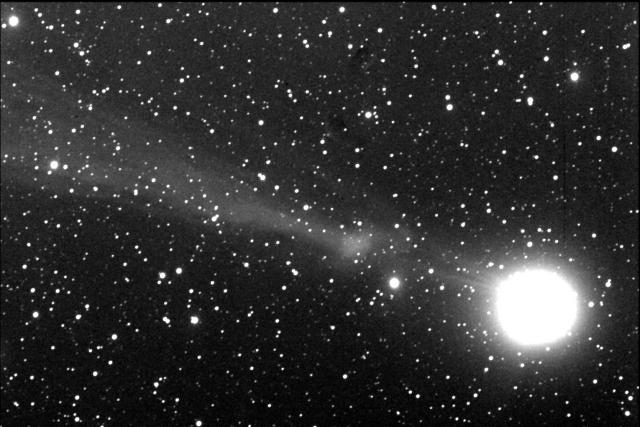 9 January 2015 at 7:30 am #576756
9 January 2015 at 7:30 am #576756 Nick JamesParticipant
Nick JamesParticipantWell done Tony on picking this up.
I was out last night at the opening of of Crayford Astro’s new observatory at Sutton-at-Hone near Dartford, Kent. About 70-80 people were there and many had a good view of the comet in various binoculars and telescopes only a mile or so from the M25.
It was very claggy in Chelmsford before I left but I took the risk of leaving a DSLR and telescope taking images in the garden when I went out. By the time I got back it had clouded over completely so I didn’t get a chance to point my main scope at the comet but the DSLR/Megrez did get some images. This stack just about shows the faint tail and disconnection event.
As always, the latest images submitted to the BAA are here.
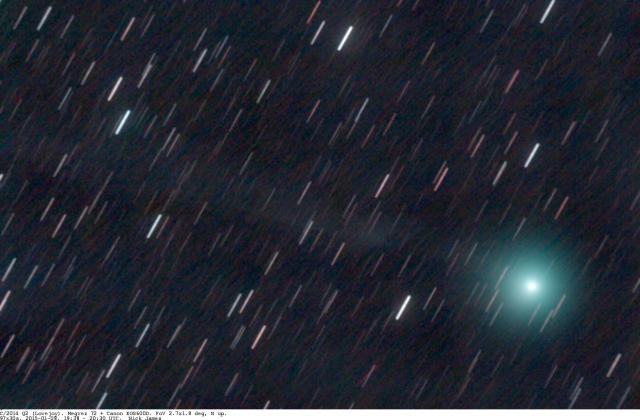 10 January 2015 at 12:19 am #576757
10 January 2015 at 12:19 am #576757 David ArdittiParticipant
David ArdittiParticipantI managed to get a similar result from Edgware in a claggy sky early on Thursday evening before it clouded-up. The disconnection is just about shown despite the LP gradient. R Ligustri’s image on Spaceweather is pretty stunning.
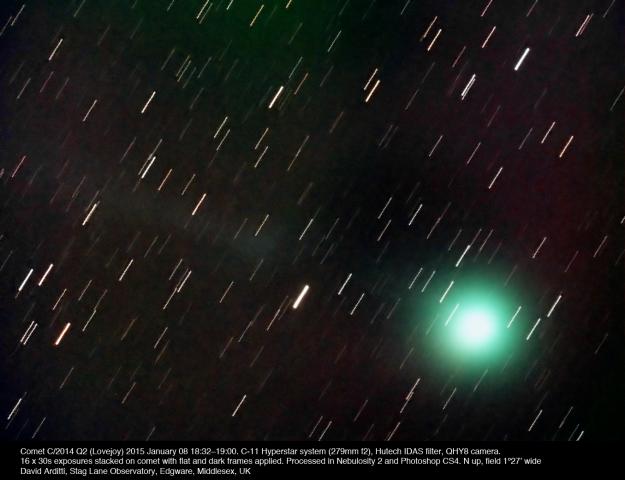 10 January 2015 at 9:42 pm #576760
10 January 2015 at 9:42 pm #576760 Mike FoylanParticipant
Mike FoylanParticipantReally amazing and stunning images there guys, well done indeed. Excuse my ignorance but what causes a “Tail Disconnection” event to occur or is it well understood?
With best wishes and clear skies
Mike
11 January 2015 at 12:16 am #576762 Nick JamesParticipant
Nick JamesParticipantMike,
The faint tail of this comet consists of gas which has come from the nucleus and which has been ionised by sunlight. This ionised gas is called a plasma and it is affected by the magnetic field that is carried along by the solar wind. Gusts in the solar wind can compress the magnetic field lines in the ion tail so that they effectively short circuit releasing a lot of energy that can sever the tail from the head.
The image below is from tonight and it has a field of view of 2.3×1.7deg. There is a lot of structure in the ion tail and this provides a direct measurement of the interplanetary magnetic field in the vicinity of the comet.
Nick.
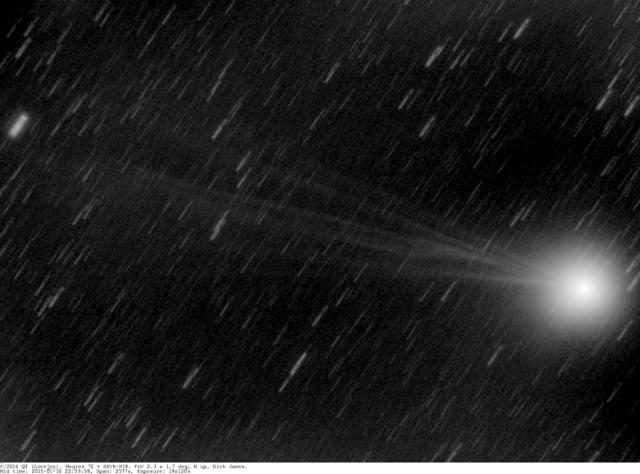 11 January 2015 at 1:42 am #576763
11 January 2015 at 1:42 am #576763 Mike FoylanParticipant
Mike FoylanParticipantThanks Nick for that interesting information and your impressive wide-angle image of comet Lovejoy. I did some visual observing tonight with 10×50 binoculars, although it had the appearance of just a fuzzy patch I do believe I seen an associated greenish colour but it was very subtle. Looking forward to more stunning images of comet Lovejoy!
Best wishes and clear skies
Mike
11 January 2015 at 7:27 pm #576767 Nick JamesParticipant
Nick JamesParticipantThe tail of this comet really does change dramatically from day to day. One of the advantages that we have now is that we can get images taken from around the globe and this allows us to get really good time resolution. The images below are all from the last night and they show tail changes over a matter of hours. Please, please, please, if you are submitting images include field of view/scale and orientation info. Without this we need to do a lot of guessing when we rescale images to look at things like this.
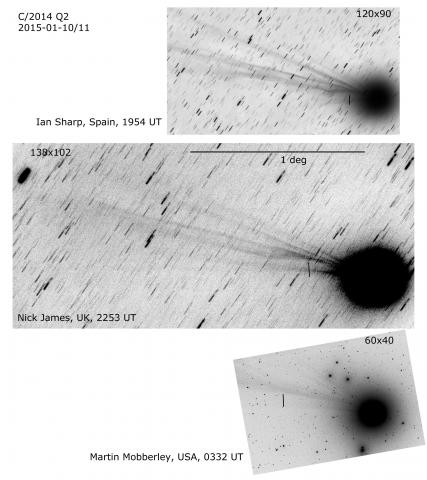
Nick.
12 January 2015 at 4:11 pm #576770 Mr Ian David SharpParticipant
Mr Ian David SharpParticipantThanks for the analysis Nick!
Ian
12 January 2015 at 11:04 pm #576771 Nick JamesParticipant
Nick JamesParticipantLast Saturday night, January 10, I left a camera running taking 60s images of this comet. I have now stacked these into groups of 20 and made an animation from the resulting 8 frames. The mid-times of these frames are from 2015-01-10 17:54:38 to 20:27:34 so just around 2.5 hr. The FoV is 68’x52′ with approximately N up. If you look carefully you can see motion of features down the tail over this short period.
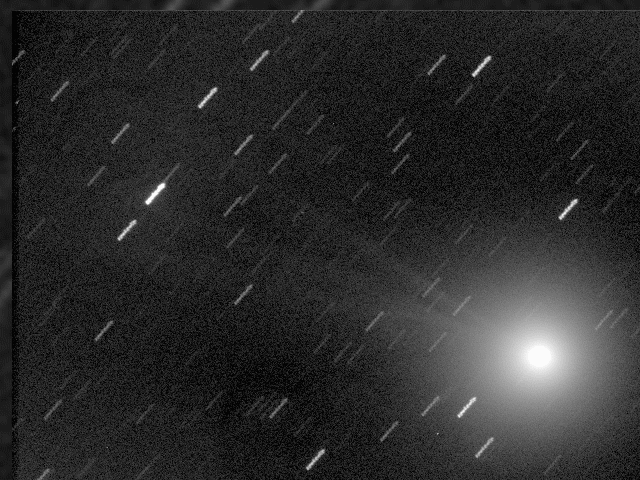 14 January 2015 at 12:35 am #576774
14 January 2015 at 12:35 am #576774 Nick JamesParticipant
Nick JamesParticipantHere’s another comparison of the tail from two stacks of images taken tonight around 6 hours apart.
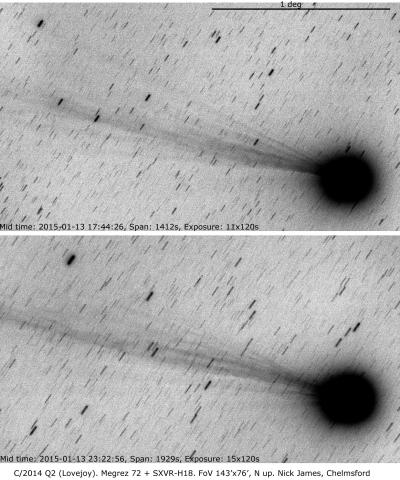
-
AuthorPosts
- You must be logged in to reply to this topic.

